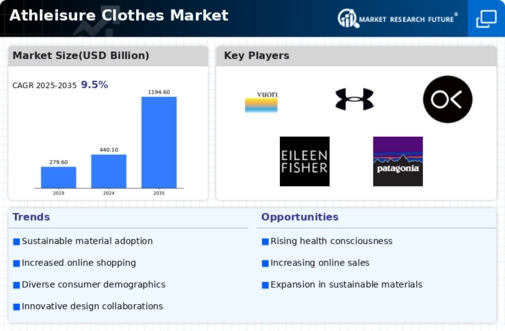Leading market players are investing heavily in research and development to expand their product lines, which will help the Athleisure Clothes market grow even more. Market participants are also undertaking a variety of strategic activities to expand their footprint, with important market developments including new product launches, contractual agreements, mergers and acquisitions, higher investments, and collaboration with other organizations. To expand and survive in a more competitive and rising market climate, the Athleisure Clothes industry must offer cost-effective items.
Manufacturing locally to minimize operational costs is one of the key business tactics used by manufacturers in the Athleisure Clothes industry to benefit clients and increase the market sector. In recent years, the Athleisure Clothes industry has offered some of the most significant advantages to fashion-conscious consumers seeking a seamless blend of style, comfort, and versatility in their everyday wardrobe.
Major players in the Athleisure Clothes Market, including Hanes Brands, Inc., Adidas AG, Vuori, PANGAIA, Under Armour, Inc., Outerknown, EILEEN FISHER, Patagonia, Inc., Wear Pact, LLC, and Lululemon Athletica are attempting to increase market demand by investing in research and development operations.
Under Armour Inc. (Under Armour) operates as a developer, marketer, and distributor of apparel, footwear, and related accessories globally. The company's diverse product portfolio includes items such as sweatshirts, socks, football gloves, shoes, sandals, performance bags, and baseball batting gloves. Under Armour employs various sales channels, including retail stores, direct-to-consumer avenues, and e-commerce websites to reach its customers. The brand portfolio encompasses well-known labels like UA, Armour, Heatgear, Coldgear, Protect This House, I WILL, Armour Fleece, and Armour Bra.
Headquartered in Baltimore, Maryland, the United States, Under Armour announced in May 2022 its strategic move to launch the direct-to-consumer (D2C) platform, UnderArmour.com, in India. This initiative is part of the company's endeavor to expand its product and service distribution in the country through its local distributor and master franchise, Underdog Athletics. Under Armour aims to capitalize on the success of its direct-to-consumer business model.
Adidas is a leading company specializing in the design, manufacturing, and marketing of athletic and sports lifestyle products. The extensive product portfolio includes footwear, apparel, and accessories such as bags, sunglasses, fitness equipment, and balls. The company employs a diverse distribution network, reaching customers through its own-branded stores, retail outlets, wholesale channels, sporting goods chains, department stores, lifestyle retail chains, e-retailers, and franchise stores. Additionally, Adidas markets its products through e-commerce platforms and mobile shopping apps. The brand operates ly, with business activities spanning the Americas, Europe, Asia-Pacific, Africa, and the Middle East. adidas is headquartered in Herzogenaurach, Germany.
In August 2022, adidas introduced a new sportswear capsule collection, showcasing versatile pieces with minimalist aesthetics. The collection emphasizes comfort and can seamlessly transition from activewear to casual wear. Notably, several items in the collection are crafted from recycled materials, aligning with Adidas' commitment to sustainability. Featured pieces include a women's rib dress, a men's classic tee paired with woven pants and a coach jacket, and a women's oversized hoodie with a rib crop top and biker shorts, among other options.
















